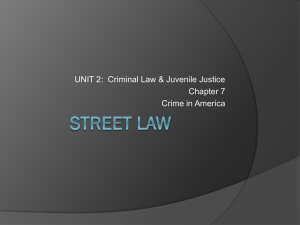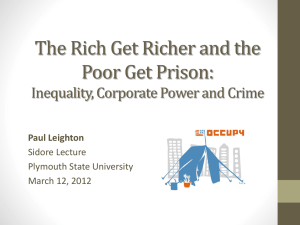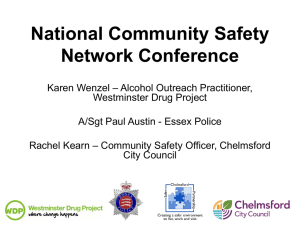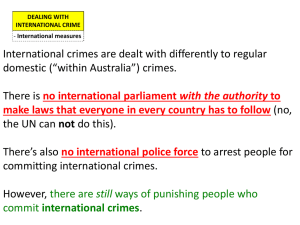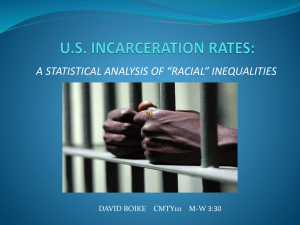Powerpoint - London School of Economics and Political Science
advertisement
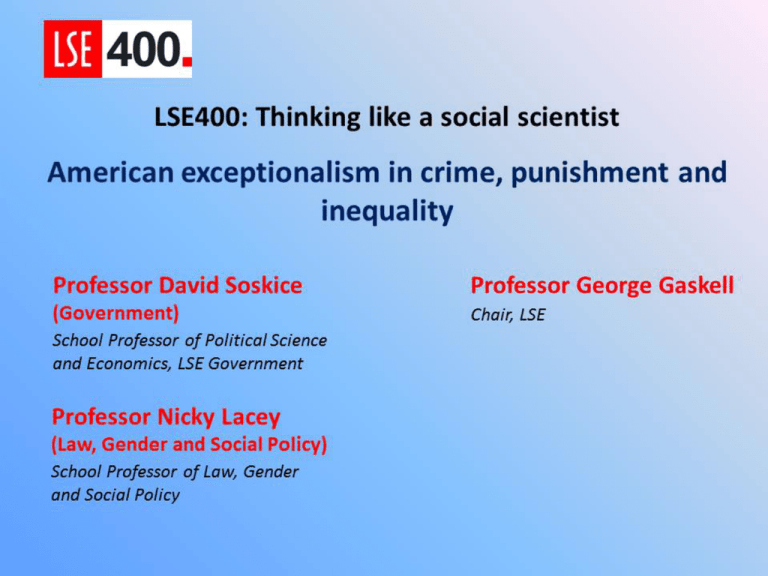
LSE 400: Thinking Like a Social Scientist American Exceptionalism in Crime, Punishment and Inequality Nicola Lacey (Law, Gender and Social Policy); David Soskice (Government) International variation in crime and punishment • Huge variations in levels of crime and punishment across states – and even between states at comparable levels of economic and political development • Opportunities afforded by these variations to build explanatory hypotheses about the linkages between not only criminal justice policy and crime, but also crime, punishment and broader social, political and economic institutions and cultural dynamics LSE 400 American Exceptionalism in Crime, Punishment and Inequality, 6 February 2015 3 Questions for comparative analysis • 1) How can we explain the different trajectories of crime and punishment in different countries? • 2) What light can a comparative analysis shed on our understanding of how patterns of crime and punishment are produced, and in particular of the relative importance of penal policy and of other factors – social and economic policy, culture, the structure of political institutions – in producing those patterns? • 3) What light can comparative studies throw on the wisdom – or possibility - of ‘transplanting’ policies from one country to another? LSE 400 American Exceptionalism in Crime, Punishment and Inequality, 6 February 2015 4 LSE 400 American Exceptionalism in Crime, Punishment and Inequality, 6 February 2015 5 The Ratio of Serious Violent Crime and of Homicides, United States, England and Wales, Canada and New Zealand, based on offences per 100,000 of the population. LSE 400 American Exceptionalism in Crime, Punishment and Inequality, 6 February 2015 6 Ic el an Ja d p N an or w F i ay n D lan en d m Sw ark Sw e itz den er la G nd re e I re c e l Be and lg iu Fr m G anc er e m a Au ny st ria I ta T u ly rk C ey an Au ad st a ra l Lu K ia x e or e N mb a et ou he r rla g O n EC Po ds D rt u av ga er l U ag ni e te d Sp Ki a ng in Sl d ov H u om ak ng R a N ep ry e C w ubl ze Ze ic ch a R lan ep d ub M lic ex ic U ni Po o te la d n St d at es Prison Population Rates 250 725 200 150 100 50 0 Source: OECD, 2007; International Centre for Prison Studies, LSE2007 400 American Exceptionalism in Crime, Punishment and Inequality, 6 February 2015 7 Imprisonment Trends (1950-2010) 200 Imprisonment per 100,000 180 160 140 120 100 80 60 40 20 USA 1950-1975 Finland England & Wales Germany Norway Netherlands Source: International Centre for Prison Studies (2010); European LSE 400 American Exceptionalism in Sourcebook of Crime and Criminal Justice (2010); John Pratt, Crime, Punishment and Inequality, 6 British Journal of Criminology (2008) February 2015 20 0 7 09 /1 0 20 06 20 04 20 00 20 95 19 90 19 85 19 80 19 75 19 70 19 65 19 60 19 55 19 19 50 0 Sweden 8 Imprisonment Trends (1950-2010) 800 USA 700 England & Wales Imprisonment per 100,000 600 Norway 500 Sweden 400 300 Finland 200 Germany 100 Netherlands 20 07 20 09 /1 0 LSE 400 American Exceptionalism in Crime, Source: International Centre for Prison Studies, 2010; Punishment and Inequality, 6 February John Pratt, British Journal of Criminology 2008 2015 20 06 20 04 20 00 19 95 19 90 19 85 19 80 19 75 19 70 19 65 19 60 19 55 19 50 0 9 An institutional explanation? • The economic dimension: labour market arrangements; production regime; education and training (Hall and Soskice 2000) • The political dimension: electoral and party systems; the bureaucracy (Lijphardt 1984, 1999) • The welfare state (Esping-Andersen 1990) • The constitution (Lacey 2008) • Inclusionary and exclusionary dynamics in both prevailing institutional structures and in culture LSE 400 American Exceptionalism in Crime, Punishment and Inequality, 6 February 2015 10 Inequality and Redistribution (ca. 1970-1995) Bel gi um 80 Sweden Po v e r ty r e d u c tio n 70 Fi nl and Nor way Net her l ands Denm ar k 60 Fr ance 50 Ger m any UK I t al y 40 Aust r al i a Canada 30 20 Swi t zer l and US 10 1.4 1.5 1.6 1.7 1.8 1.9 2 2.1 d9/d5 ratio Source: Torben Iversen and David Soskice, ‘Distribution and Redistribution: The Shadow of the Nineteenth Century’, (2009) 61:3 World Politics 438-86: LSE 400 American Luxembourg Income Study and OECD. Exceptionalism in Crime, Punishment and Inequality, 6 February 2015 11 Vocational Training and Redistribution Bel gi um 80 Denmark Fi nland Norway Netherl ands Sweden Po v e rty re d u c tio n 70 Franc e 60 UK 50 Germany Ital y Aus tral ia 40 Canada 30 20 Swi tz erland USA 10 0 10 20 30 40 Vocational training intensity Source: Torben Iversen and David Soskice, ‘DistributionLSE and 400 American Exceptionalism in Crime, Redistribution: The Shadow of the Nineteenth Century’, (2009) Punishment and Inequality, 6 February 61: 3 World Politics 438-86 UNESCO 1999. 2015 50 60 12 Literacy and Education, (1994-8) 30 15 0 45 60 Irel and Uni t ed Ki ngdom U. S. New Zeal and Canada Aust ral i a Bel gi um (Fl anders) Fi nl and Net herl ands Germany Norway Denmark Sweden 0 5 10 15 20 25 NOTE: The top bars (using top scale) show the percentage of adults who have not completed an upper secondary education but have high scores on document literacy. The bottom bars (using bottom scale) show the percentage of adults taking the test who get the lowest score, averaged across three test categories. Source: Torben Iversen and David Soskice, ‘DistributionLSE and400 American Exceptionalism in Crime, Punishment and Inequality, 6 February Redistribution: The Shadow of the Nineteenth Century’, (2009) 61: 3 World Politics 438-86 2015 13 United States United Kingdom Australia New Zealand Canada Residential Segregation: (Ethnic) 10.8 [11.4] Black 1.7 [9.9] S Asian 0.1 [2.7] Asian 0.0 [19.6] Maori 1.4 [11.2] Asian Prison per cap 701 141 115 155 129 73 Homicide rate 5.2 1.2 1.2 1.3 1.85 0.9 Literacy score 5th 136.7 percentile 151.2 145.1 164.8 144.5 214 Child poverty 12.1 10.9 11.7 13.3 7.3 23.1 Swe Notes: (1) Residential segregation: % population in large cities living in tracts where (a) > 70% ethnic (non-white), (b) one ethnic group dominant, (c) > 30% of group in city live in these tracts. The number in [] is % of main ethnic group in cities analysed. 2001-2 Johnston, Poulsen, Forrest, ms 2005 (2) Prison data 2002-3; 2004 Canada (3) International Adult Literacy Survey 2000 OECD (4) Unicef, 2012 LSE 400 American Exceptionalism in Crime, Punishment and Inequality, 6 February 2015 14 Methodological question: similarity vs difference in comparative analysis • Difference tends to become salient in comparative research, but… • Similarity also needs to be explained. • Our analysis in this lecture focuses on explaining the very stark differences just described, but… • Here is one striking similarity, the explanation for which must be part of any full analysis: LSE 400 American Exceptionalism in Crime, Punishment and Inequality, 6 February 2015 15 Gender and Crime: US LSE 400 American Exceptionalism in Crime, Punishment and Inequality, 6 February 2015 16 Gender and Crime, UK LSE 400 American Exceptionalism in Crime, Punishment and Inequality, 6 February 2015 17 Gender and Crime: UK LSE 400 American Exceptionalism in Crime, Punishment and Inequality, 6 February 2015 18 Women as % of prison population on latest World Prison Brief data • • • • • • • • • USA Australia Sweden Germany Scotland Canada England and Wales Ukraine France 9.0% 7.7% 5.8% 5.7% 5.4% 5.1% 4.5% 4.4% 3.3% LSE 400 American Exceptionalism in Crime, Punishment and Inequality, 6 February 2015 19 US Canada Police Prosecutors Local judges Zoning Schools City/municipal app DA elected county or Most states Zoning Boards Property tax by by mayor multi- county district elected on county appointed by locally elected School Board (sometimes or multi-county elected at School District elected) district Council/Mayor Provincial Provincial, Federal government defined policies Office of Provincial Provincial AG AG; operating Provincial policies procedures, appointments, training England Home Office Attorney General Lord Chancellor Min Housing rules, and Wales appoints Chief (government agency) (Ministry of Justice) right of appeal to Constables NZ National govt policies Minister Government Attorney General appoints (under appoints (remain Min of Police, private lawyers) prosecution national guidelines Attorney General National guidelines National system (Ministry of Education) independence) LSE 400 American Exceptionalism in Crime, Punishment and Inequality, 6 February 2015 20 LSE 400 American Exceptionalism in Crime, Punishment and Inequality, 6 February 2015 21 LSE 400 American Exceptionalism in Crime, Punishment and Inequality, 6 February 2015 22 Most serious violent crime committed by men from late teens to late 20s; largely in big cities Very largely from underprivileged families and with weak education – high school dropouts in US, early leavers UK Start with UK and US: UK bad and US worse if we go back to 1950s – (compared to Germany and Sweden) But from 1970s to mid 1990s UK violent crime doubled but US quadrupled Since mid 1990s violent crime halved in UK and US – though differences across cities So 3 periods of violent crime in UK and US: 1950s and 1960s relatively low 1970s through mid 1990s doubles in UK quadruples in US mid 1990s to present falls significantly (roughly halves) UK and US Key methodological hypothesis: Choosing crime is like many (perhaps most) other choices of economic and educational activities made by young people from mid teens to mid twenties Constrained choice: My background is given (imagine socially underprivileged and bad schools): What jobs are available given my education, skills and social connections? Does it pay me to invest more in education and skills (what sort?) and social connections (what sort?) to increase choice of jobs/activities (inc crime)? Good period: 1950s and 1960s These choices depend on job opportunities provided by labour markets – and these change hugely across the 3 periods 1950s 1960s: Huge ‘Fordist’ assembly line auto plants etc needed semi-skilled (male) workers – learn simple range of tasks requiring physical dexterities and stamina, plus discipline social skills not important, education level not important (but don’t drop out of high/secondary school – bad signal for accepting discipline) strong unions bargained good wages and conditions Good period: 1950s and 1960s 1950s 1960s: choice not difficult even if from bad schools/background with limited social connections – accept discipline and get decent job and avoid crime because that risks losing decent jobs and difficulty getting back in with criminal record Bad period: mid 1970s to mid 1990s Mid 1970s to mid 1990s Growing consequences of Information technology revolution: many good effects but ….. implies gradual collapse of Fordism/ end of decent mass semi-skilled employment for low-educated young males bad period for big cities where most big Fordist plants located – especially in US: eg Chicago, New York nearly go bankrupt Difficult choices for disadvantaged young males: (1) Upgrade educationally. Standard middle class choice as proportion staying on for higher education and hence better careers generated by IT revolution. But requires good schools and social connections. Bad period: mid 1970s to mid 1990s Choice (2): work legally in low-skill employment, (non-unionized); but real hourly earnings for low-skilled males collapse in this period (here shown for US): low-skill male real hrly earnings in US Bad period: mid 1970s to mid 1990s Choice (3): invest in crime, build ‘bad’ social connections in high school and/or drop out in US, this typically involved membership of street gang ability to earn money from protection and drug-sales (more later) Conclusion for Bad Period For young males from really disadvantaged backgrounds, bad schools, low ‘cultural/social’ capital, no/limited social connections to employment, legal jobs pretty shit jobs, then crime not a stupid choice – despite all long-term consequences Methodological Interlude Methodology: This approach often called ‘rational choice’: (i) Individuals have ‘preferences’: most people want: to live comfortably (earn money) to be approved of (even admired) by their friends and colleagues (ii) Individual has ‘assets’: human capital (education background); social/cultural capital: social background, social connections (eg to potential employers, often indirectly), ability to communicate with those from different backgrounds LSE 400 American Exceptionalism in Crime, Punishment and Inequality, 6 February 2015 32 Methodological Interlude (iii) Given his or her assets, the individual has ‘choices’, and these can and do change over time - when industry (1950s/1960s) demanded physically fit young men prepared to accept industrial discipline, and it didn’t require significant education or social/communicative skills, that gave one set of choices - and when those choices were eliminated (mid 1970s on), the choice set narrowed for those with low/poor education and social capital (iv) Given his or her assets, preferences and choices, the individual chooses what he sees as best available option. (1) Why such a huge increase in violent crime in large US cities (mainly the exindustrial cities where semi-skilled employment had collapsed)? (2) Why was increase in violent crime in US much larger than in UK (even though same basic cause – collapse of semi-skilled employment for less educated young men)? (1) So why such a huge increase in violent crime in large US cities (mainly the exindustrial cities where semi-skilled employment had collapsed)? We’ll see that young men with poor education and who couldn’t get decent jobs; a large proportion of whom were black (some Hispanic); lived in densely populated very poor areas in city centres (de facto ethnic ghettos) residential segregation or sorting And then we’ll look at why living in these ghettos generated such a high level of serious violent crime Huge increase in US violent crime mid 1970s to mid 1990s: (1) Residential Segregation US cities ‘herd’ the poor (especially poor blacks, also poor hispanics) into densely populated tracts/neighborhoods; these are the Truly Disadvantaged - William Julius Wilson US often called the ‘sorting society’ – sorting class/ethnicity residentially Here’s an ethnic map of Chicago: red dot: 25 White residents gold: 25 Hispanic residents blue: 25 Black residents; the more intense the colour, the denser the population check median income here tract by tract: http://www.chicagobusiness.com/article/20130108/BLOGS08/1 30109821/how-rich-is-your-neighborhood Huge increase in US violent crime mid 1970s to mid 1990s: (1) Residential Segregation Which very large US cities? https://www.flickr.com/photos/walkingsf/4982041 458/in/set-72157624812674967/ Huge increase in US violent crime mid 1970s to mid 1990s: (1) Residential Segregation Addendum: a great website for flicking between median income tract by tract and race tract by tract is: http://www.umich.edu/~lawrace/citymaps.htm/chicago.htm http://www.umich.edu/~lawrace/citymaps.htm US often called the ‘sorting society’ – sorting class/ethnicity residentially Huge increase in US violent crime mid 1970s to mid 1990s: (1) Residential Segregation And which are these very large US cities? Huge increase in US violent crime mid 1970s to mid 1990s: (1) Residential Segregation United States United Kingdom Australia New Zealand Canada Sweden Residential Segregation: (Ethnic) 10.8 [11.4] Black 1.7 [9.9] S Asian 0.1 [2.7] Asian 0.0 [19.6] Maori 1.4 [11.2] Asian Prison per cap 701 141 115 155 129 73 Homicide rate 5.2 1.2 1.2 1.3 1.85 0.9 Literacy score 5th percentile 136.7 151.2 145.1 164.8 144.5 214 Child poverty 23.1 12.1 10.9 11.7 13.3 7.3 Notes: (1) Residential segregation: % population in large cities living in tracts where (a) > 70% ethnic, (b) one ethnic group dominant, (c) > 30% of group in city live in these tracts. The number in [] is % of main ethnic group in cities analysed. 2001-2 Johnston, Poulsen, Forrest, ms 2005 (2) Prison data 2002-3; 2004 Canada (3) International Adult Literacy Survey 2000 OECD (4) Unicef, 2012 Huge increase in US violent crime mid 1970s to mid 1990s: (1) Residential Segregation Some more detailed comparative data on (ethnic) residential segregation in matched cities in US compared to UK, Canada, NZ Huge increase in US violent crime mid 1970s to mid 1990s: (1) Residential Segregation Why so much higher residential segregation in US cities compared to elsewhere? Free market property forces? In most rich capitalist countries the better-off live in nicer places – but that doesn’t distinguish US from UK where residential segregation much lower But unlike elsewhere, American cities have Zoning Laws which say how many houses per acre and how many families per building; these laid down for each neighborhood; so a 2 house per acre/ one family per building zoning rule keeps poor families very effectively out And ethnicity (blacks, Hispanics) highly correlated with income/class Huge increase in US violent crime mid 1970s to mid 1990s: (2) Educational Segregation (de facto) So disadvantaged largely black/hispanic young men with weak job prospects in these highly residentially segregated poor areas Strongly reinforced by de facto educational segregation: So despite famous Supreme Court decision in Brown vs Board of Education (1954) making school segregation illegal …. Residential segregation means education remains highly segregated for low income groups And US cities choose to spend much less on schools with high poor/Black/Hispanic children: these ghetto schools often very bad Mental note: 2 policies which have adverse reinforcing impact on the already disadvantaged in US (1). Using Zoning Laws creating residential segregation (2). Significantly lower funding for (de facto racially segregated schools in these poor areas, reinforcing low educational performance How do we actually know that there is ‘lower funding for (de facto racially segregated) schools 60% slope of line is -..174 . Share of City Spending on Education . . . . . . . . in these poor areas in US cities’ as I’ve just claimed? 0 % 0 % % Ethnic 50% in City Huge increase in US violent crime mid 1970s to mid 1990s: (2) Educational Segregation (de facto) Collapse of decent jobs for males with low education and social skills; but accept discipline From 1980s on, decent careers require good education and social (and cultural) skills Disadvantaged Youth Low Resources for Residentially Segregated Schools Educational Segregation Bad schools Legal employment is sink v low pay employment ? Thus crime attractive but why violent crime? Before seeing why violent crime developed in such a huge way in US compared to UK we can check that these areas (poor ethnic inner city areas) were in fact the areas of violent crime we’ll actually see this had a great deal to do with street gangs; these were always feature of big city life in US – back to Irish and Italians in C19th; but they really develop from mid 1970s through to early 1990s and key question for us is why? http://chicagogangs.org/ index.php?pr=GANG_MAP_SOUTH LSE 400 American Exceptionalism in Crime, Punishment and Inequality, 6 February 2015 49 Huge increase in US violent crime mid 1970s to mid 1990s Huge increase in US violent crime mid 1970s to mid 1990s: why did gangs develop in this period? 3 factors led to big surge in gangs (1) As we’ve argued: A lot of disadvantaged young men, largely ethnic, with minimal labor market attachments, in these deeply poor neighborhoods, in effect for whom crime is sensible choice; (prison for 6 months or a year – normal length (??Check) – almost rite of passage) Huge increase in US violent crime mid 1970s to mid 1990s: why did gangs develop in this period? 3 factors led to big surge in gangs (2) As these neighborhoods became worse thru 1970s and 1980s – unemployment rising, businesses incl retail moving out – middle classes also moved out A key element for any community to work – some form of social organization – became much weaker. These became increasingly what sociologists call areas of ‘social disorganization’ Huge increase in US violent crime mid 1970s to mid 1990s: why did gangs develop in this period? 3 factors led to big surge in gangs (3) These poor areas were always areas with very limited police presence on foot – and now police presence was largely in well-armed and defended police cars So gangs caused by total lack of protection for individuals in bad areas, and social disorganization. Young men carried weapons of self-defence. Violence easily broke out. Joining gangs meant relative safety; enabled drug-dealing, as well as money from protection. Much of the gang violence came from establishing gang turf between neighborhoods. Also, enforcing payments eg from drug dealers. Three US policies which really ‘caused’ huge rise in violence in US compared to UK (1). Zoning: Using Zoning Laws creating residential segregation (2). Education: Significantly lower funding for (de facto racially segregated schools in these poor areas, reinforcing low educational performance (3). Policing: Significant under-policing of poor areas, with beat policing almost absent Big difference between US and UK policy-making in these areas: In UK (and Canada, NZ and Australia) policies in these 3 areas made at national (or state/provincial) level But in US policies in these 3 areas made at local or city level: by democratically elected mayors and city councils, or school boards Similar difference between US and UK policy-making in two other areas: state prosecution (District Attorneys or DAs) and district judges In UK (and Canada, NZ and Australia) appointments of public prosecutors and judges is made at national (or state/provincial) level But in US DAs and district judges (who judge all criminal cases in first instance) are directly elected at county or city level in special elections US POLICE STATE PROSECUTORS DISTRICT JUDGES ZONING SCHOOLS City/municipal app by DA elected county or multi- Most states elected on Zoning Boards appointed Property tax by elected mayor (sometimes county district county or multi-county by locally elected School Board at School district Council/Mayor District Provincial government Provincial, Federal defined Provincial policies elected) Canada Office of Provincial AG; Provincial AG operating procedures, policies appointments, training England and Home Office appoints Attorney General Lord Chancellor Min Housing rules, right of Wales Chief Constables (government agency) (Ministry of Justice) appeal to Minister NZ Government appoints Attorney General appoints Attorney General National guidelines (under Min of Police, (remain private lawyers) prosecution national guidelines independence) National govt policies National system (Ministry of Education) So why does this matter whether rules/policies/appointments made at national level or city/local level? Fundamental difference between US political system and that of every other advanced country: Huge range of decisions left to local voters without any national (federal/state) framework (why its different from Switzerland) This goes right back in history This matters most to home owners: - their home usually their main capital asset; - and its value depends on local environment: (i) on low property taxes: so do things as cheaply as possible for us (ii) on ‘nice’ neighbors (read ‘neighbors like us’) so zoning rules to keep ethnic poor away from us (this is costless) (iii) on local safety (especially from violence): so effective policing for us, but not for poor areas where effective policing expensive and poor beat up poor (iv) on good schools (for our children): so don’t spend our property taxes on schools in poor areas Home owners are the dominant voters: (1) frequently close to a majority of home owners (largely white) (2) home owners well-organized in ‘neighborhood’ or ‘homeowner’ associations; and they ensure turnout to vote and participation in zoning board meetings etc (3) the poor areas are socially disorganized and turn out low Why are results different in national elections? (1) Generally much bigger turnout at national elections, say 70% versus 30%. So decisive voters in national elections lower income & don’t want rigid zoning rules (2) ‘Negative externalities’: Governments at national level want disadvantaged groups to have reasonable education, because illiteracy spills over to economic and social problems throughout country – as do bad pockets of crime in city centers. LSE 400 American Exceptionalism in Crime, Punishment and Inequality, 6 February 2015 64


